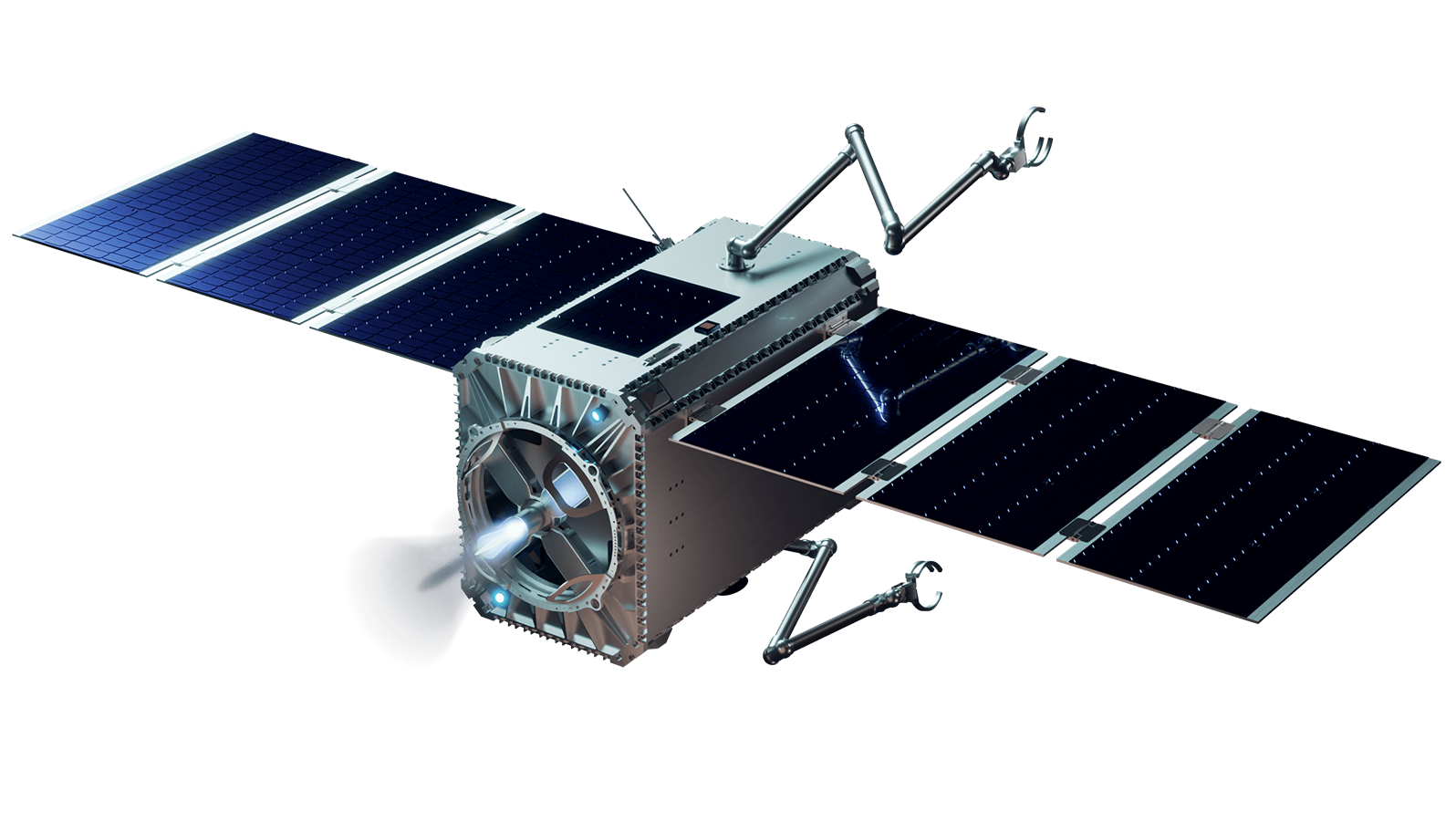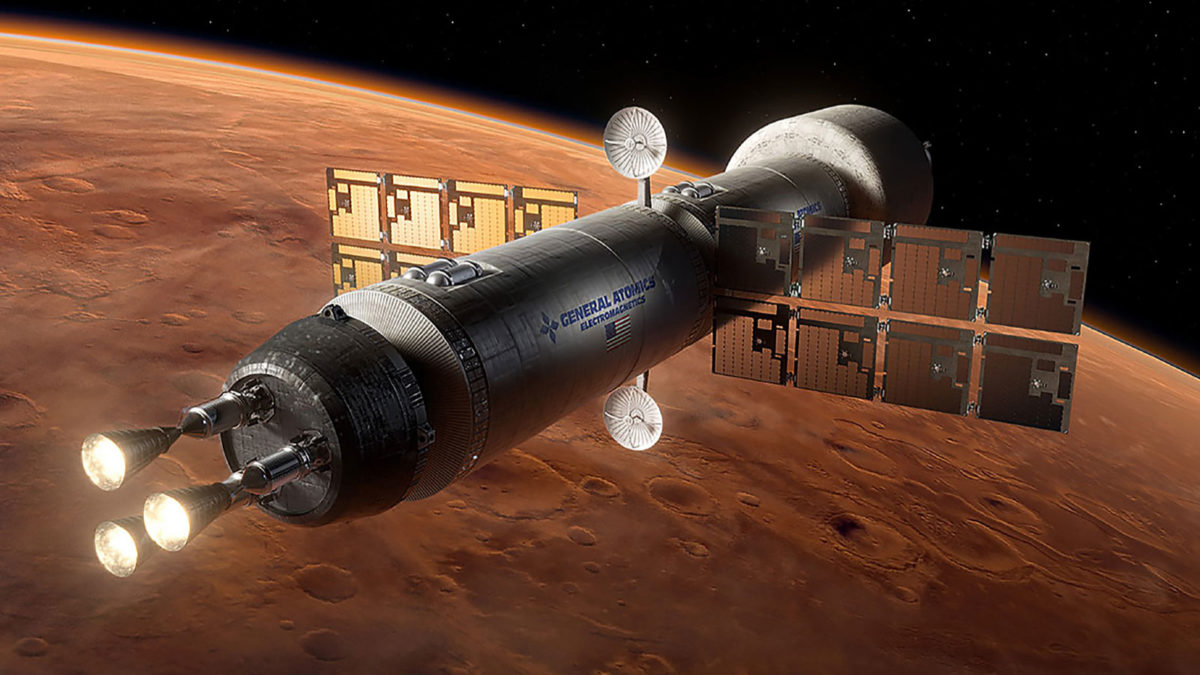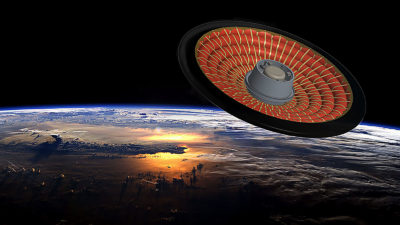Nuclear rocket redux
By Jon Kelvey|January 2023
The United States has had multiple dalliances over the decades with in-space nuclear propulsion. The latest resurgence of interest is happening right now, driven by the desire to settle the moon and get humans to Mars. Jon Kelvey looks at the odds of success this time around.
Progress on space technology has often begun with grandiose visions unrestrained by the realities of budgets and environmental and regulatory reviews. So imagine: It’s 2028 and the crew of NASA’s Artemis V moon mission is stuck on the lunar Gateway space station in orbit around the moon — and the power just went out. The space agency desperately needs to get another power and propulsion unit to the Gateway immediately, but the Advanced Electric Propulsion System spacecraft that ferried the original PPE to the station will take weeks to arrive, and the space agency can’t stand up another of its massive Space Launch System rockets fast enough either.
If Tabitha Dodson has her way, the U.S. Space Force could come to the rescue, propelling the PPE there from Earth orbit with the next generation of atomic age technology, as envisioned by DARPA. “And it wouldn’t take a third of the year to get it there. It would take a day or so,” she says.
Very rapid delivery of large cargo over long distances: That’s the tagline for nuclear thermal propulsion, or NTP. A screaming hot nuclear fission reactor would heat liquid hydrogen propellant into a gas and accelerate it out a nozzle. The result would be high thrust and fuel efficiency that, at least in theory, outclasses chemical rockets and electric thrusters alike. The U.S. has never launched a nuclear reactor into space for the purposes of propelling a spacecraft, but it’s not for lack of trying. It’s on old idea, explored by NASA and the Atomic Energy Commission beginning in 1958 after the two agencies inherited a research program from the U.S. Air Force. Dodson, a DARPA nuclear physicist, is helping to lead that rebirth as the chief engineer and manager of the Demonstration Rocket for Agile Cislunar Operations, or DRACO, program. NASA is also rekindling research into nuclear propulsion, with plans to demonstrate a fission reactor-powered NTP system in space by the early 2030s.
With DRACO, DARPA aims to design, build and fly an NTP-powered spacecraft in orbit by fiscal 2026. If all goes as planned, it could serve as the basis of a Space Force fleet of NTP rocket upper stages that could push big satellites around.
“Our missions are looking at going into the cislunar volume beyond Earth orbit,” says Dodson.
So nuclear is in the air, so to speak, but not literally. In fact, that’s one of the challenges to wider adoption: Experts and the public alike must be convinced that putting nuclear reactors on rockets will be safe. Combine safety concerns, real and perceived, with the remaining technical challenges to building a functional NTP system, and the task before DARPA and NASA looms large. Add to that a third challenge, the federal regulatory and budget landscape, and you start to get a sense of why NTP never took off in the 1970s and why questions remain about whether matters will unfold differently this time.
Why go nuclear?
Each year, MIT professor of aeronautics and astronautics Paulo Lozano teaches a rocket propulsion class. “Recently, I have been adding a few lectures on nuclear, precisely because I think it’s kind of coming back,” he says.
It’s not just that NASA and DARPA are researching NTP. It’s what they are researching those systems for — pushing big payloads to geosynchronous orbit and beyond quickly, building moon bases and going to Mars. You don’t need NTP to do those things, Lozano says, but it’s a much more flexible option.
“I think nuclear propulsion has its niche application, which is fast transport to deep space destinations,” he says. “That is something that very likely nuclear can do better than any other technology.”
For NASA, an uncrewed space demonstration of an NTP system by the early 2030s could open the door to an alternative way of propelling human missions to Mars, says Anthony Calomino, who manages the Space Nuclear Technology Portfolio within NASA’s Space Technology Mission Directorate. With NTP, a spacecraft could make the journey in four to six months, rather than the nine months typically required when using chemical propulsion.
Getting to Mars faster isn’t just a matter of convenience — It could be a survival measure. Astronauts spending long durations outside the protective shield of Earth’s magnetosphere will be exposed to high- energy galactic cosmic radiation that could irreparably damage their DNA. Historically, there’s been a few ways of thinking about that problem, according to Michael Neufeld, a senior curator at the Smithsonian’s National Air and Space Museum.
“Either we have to have much better radiation protection,” he says (which costs mass and material), or accept the heightened health risks or “we need to have a nuclear rocket so that we’re not spending so many months in transit.”
Closer to home, Denver-based Atomos Space is developing an NTP space tug for delivering satellites to higher orbits after launch, though the company will likely use solar-electric propulsion in the short term.
“The long-term vision of that is fielding space nuclear technologies because it is the best way to move around in both near-Earth orbit and beyond,” Atomos co-founder and CEO William Kowalski says. “It’s really how we make solar systems small.”
The main advantages of NTP over conventional chemical rockets stem from the basic physics of space propulsion. Any engine will provide some amount of thrust, and do so by expelling propellant with a degree of efficiency, the engine’s specific impulse, measured in seconds. A chemical rocket engine, such as each of the RS-25s that powered the space shuttle orbiters and that power the core stage of NASA’s Space Launch System rockets, generates a large amount of thrust, around 2,277,489 newtons, with a fairly modest specific impulse of 452 seconds in space. That’s about as efficient a chemical rocket engine can be made, according to Lozano.
Electric propulsion engines, such as the Hall thrusters on SpaceX Starlink satellites, generate around 1 newton of thrust or less, but do so with great efficiency, scoring specific impulses of thousands of seconds.
NTP systems can produce both higher thrust and higher specific impulse than chemical rockets. The Nuclear Engine for Rocket Vehicle Application, or NERVA, engine developed in the United States in the 1950s, ’60s and ’70s was never launched, but in ground testing produced 246,662 newtons of force with a specific impulse of around 841 seconds.
“Specific impulse scales approximately as the square root of the exhaust temperature of the propellant divided by the molecular weight of the propellant,” Dodson says. Use hydrogen for the lowest atomic weight possible, then “get the reactor to be very hot, and you can drive up this specific impulse.”
Crucially, there is no combustion involved in NTP. Cryogenic hydrogen is superheated by the reactor but doesn’t burn, removing the need for carrying the extra mass of an oxidizer. “So the initial mass of the spacecraft is not as large as what it would be if it were a chemical-based system,” Lozano says.
You could therefore launch a powerful NTP upper stage on a smaller conventional rocket — which is just what NERVA was supposed to accomplish more than 50 years ago.
Moon shots and nuclear rockets
In May 1961, then-U.S. President John F. Kennedy gave a speech to Congress that has since become for famous pointing America toward the moon. But as Dodson notes, Kennedy didn’t just shoot for the moon. He went on to say the nation should “accelerate development of the Rover nuclear rocket. This gives promise of some day providing a means for even more exciting and ambitious exploration of space, perhaps beyond the moon, perhaps to the very end of the solar system itself.”
Project Rover was the U.S. effort to design a nuclear-powered rocket engine, originally for the upper stage of an intercontinental ballistic missile. When the Air Force transferred the program to NASA, it was incorporated into NERVA and the focus became propulsion for long-duration spaceflights. Based at Los Alamos National Laboratory in New Mexico, Project Rover began in 1955 and lasted until 1973, when NASA and national priorities changed.
“It grew out of a combination of the atomic enthusiasm of the 1950s combined with the space enthusiasm of the 1960s,” Neufeld says. NASA had plenty of money at the time, “so it was easy to imagine that NASA could incorporate a nuclear thermal rocket into post Apollo planning.”
With an NTP rocket, Dodson says, NASA could move big cargo to the moon and beyond, but with much smaller propellant tanks. “So even bigger cargo to the moon, or more cargo faster,” she says.
Engineers at the time designed the NERVA engine around a graphite core reactor fueled by highly enriched, or “weapons grade,” uranium. The reactor and engine functioned well in at least six ground tests between 1964 and 1969, producing around 1,100 megawatts of power on average.
But NERVA eventually fell victim to the same post-moon-landing malaise that would lead to curtailment of the Apollo program after the Apollo 17 landing in 1972.
“NASA’s budget effectively was halved between 1966 and the mid ’70s,” Neufeld says. “It just wasn’t sustainable to say, ‘We still need a nuclear thermal program.’” The program was canceled in 1973.
NERVA never would fly in space. The only U.S. nuclear fission reactor to do so was on the SNAP-10A satellite launched in April 1965, but that reactor was not for propulsion, but rather intended as a test case for generating electricity for satellites as part of NASA’s System for Nuclear Auxiliary Power program.
Interest in nuclear propulsion continued to simmer, however. The late 1980s and early 1990s saw research into a new NTP rocket design funded by the Strategic Defense Initiative and further developed as the Air Force Space Nuclear Thermal Propulsion program, but that effort was canceled in 1994. NASA’s ambitious Jupiter Icy Moons Orbiter, JIMO, mission of the early 2000s would have used nuclear electric propulsion with a fission reactor powering ion thrusters, but the mission was canceled in 2005.
None of those projects got as far as NERVA did in terms of testing a working engine. “Now we’re sort of picking the NERVA back up off the shelf,” Dodson says.
Engineering a modern nuclear rocket
But picking NERVA up off the shelf isn’t just a matter of building a new engine to the specifications of the older system. NERVA never flew, and there remain a number of challenges — technical and political — to making NTP an operational reality.
For one thing, it’s not clear that everything worked on NERVA as well as NASA would demand today, says Calomino.
“They didn’t necessarily know the amount of damage that was being done to the material,” he says. “How long can that engine work? Can you man rate that engine? Can you use it in an application with the reliability that you need?”
Handling heat is the key challenge for NTP. Higher heat provides higher specific impulse but also degrades the engine components, limiting their operational lifespan. This is especially true of the nuclear fuel in the reactor core, according to Paolo Venneri, who manages the advanced technologies division at Ultra Safe Nuclear Corp. The Seattle-based company was a supporting contractor to two of the primes awarded Phase 1 contracts, Blue Origin and General Atomics.
For an NTP engine, “the outlet temperature of the reactor is something on the order of 3,000 Kelvin, or 2,700 Celsius,” Venneri says. “Today, there’s no nuclear fuel that can operate at that temperature for the desired period of time.”
And about that fuel: NERVA used weapons grade uranium, meaning ore that’s enriched to consist of at least 85% uranium 235, an isotope that’s more amenable to fission than the uranium 238 also found in ore. Use of such fuel is highly restricted because of nuclear proliferation concerns, so all the current NTP research programs focus on the use of high-assay low-enriched uranium, or HALEU, which is enriched to levels of about 20% — lower than weapons grade, but higher than the 5% enrichment levels used in traditional nuclear reactor power plants.
But using HALEU introduces material design challenges too, says Dodson. With less fissionable material in the core, reactor designs must introduce moderating materials to slow down high-energy neutrons enough that they strike and split additional uranium atoms and keep the nuclear chain reaction going.
These are really challenges of materials science, according to Calomino, who came to NASA with a materials science background. Those materials science research techniques have come a long way in half a century.
“Our [abilities] to model these systems have advanced in the last 50 years,” he says. “Some of these possible showstoppers, we have solutions to them.”
Modeling can help identify hot spots in a reactor core where damage could occur, Calomino says, while advanced moderating materials — including beryllium and metal hydrides — can slow neutrons down enough to allow fission with HALEU fuel.
“These moderators are actually an enabling capability for space reactors,” he says, “to get low enriched uranium space reactors into the volume and mass bucket that we need them in to actually make them practical systems.”
Nuclear rocket safety
Because you’re talking about putting a nuclear reactor on a rocket, safety is a challenge to the future of NTP, and it’s both an engineering problem and a public relations problem.
“The public takes a lot of convincing when you’re launching uranium on a spacecraft,” Neufeld says, noting that there were protests in 1997 around the launch of NASA’s Cassini probe due to the spacecraft carrying plutonium in its Radioisotope Thermoelectric Generator.
While the idea of splitting atoms rather than simply housing pellets of plutonium, as an RTG does, might sound scarier, in Venneri’s view, uranium fission reactors actually pose less of a risk should something go wrong on the launchpad.
“Until you turn them on, they’re not radioactive,” he says. By contrast, the plutonium in an RTG is always shedding dangerous radiation as it undergoes natural nuclear decay, a process that releases the heat that’s used to generate electricity.
Safety mechanisms then must center around ensuring the reactor cannot turn on before reaching a safe orbit, even under emergency conditions, such as fission-enhancing water infiltrating the reactor core, Venneri says.
“It’s a matter of putting poisons inside of the reactor that prevent it from turning on in case of an accident,” he says — “poisons” like a neutron-absorbing rod of boron carbide. “If you just insert one of these inside of the reactor, that’s just about the most effective way of killing it that there is.”
Rules and costs
Not surprisingly, where there are safety questions, the government is never far behind. “Truly, what would squash the idea of a nuclear-powered OTV, or orbital transfer vehicle, would be regulation,” says Atomos Space’s Kowalski.
The past few years have generally been favorable to proponents of space nuclear, in terms of movements in government. In August 2019, for instance, then-President Donald Trump issued National Security Memorandum 20, which gave sponsoring agencies authority to launch NTP engines fueled by HALEU.
“In the prior framework, to prepare for launch approval, analysts would get stuck in ‘analysis paralysis’ and years of back-and-forth,” Dodson says. With the memorandum, in the case of DRACO, the Defense Department will be able to make the final call to launch the NTP flight demonstration rather than needing the thumbs up from the Executive Office of the President.
Also, Trump’s Space Policy Directive-6, issued in December 2020, discourages the use of weapons-grade uranium except in cases where HALEU fuel is not feasible, and encourages private sector involvement developing NTP systems and setting up separate launch oversight for private enterprises.
“It laid out the different launch processes for government and commercial launches, and then directed that any launch by a commercial company will be regulated by the FAA,” Venneri says. “The FAA now is figuring out how to do this.”
FAA declined to comment on its efforts regarding Space Policy Directive-6.
To test the regulatory framework, Atomos Space hopes to launch a reactor into space sometime in the mid-2020s. The fission reactor would generate electric power, rather than thrust for propulsion, since the main purpose is to test how the incipient regulatory and licensing processing actually plays out for a private company.
But all the supportive regulations and executive memos in the world might not be enough to get these new systems off the ground if Congress loses interest in missions that require NTP. If Congress chokes off funding, DRACO might well produce another NERVA — a proof of concept that immediately gets mothballed.
“What it really amounts to at the core is, ‘Is there money for an ambitious human spaceflight program beyond the moon?’” Neufeld says. “My personal opinion about Artemis and so forth is that it’ll turn out to be pretty expensive to try to develop a permanent base on the moon. And I’m not expecting Mars to be happening anytime soon.”
But unlike during the Apollo era, today’s NTP isn’t just for Mars missions and moon bases. The rapid proliferation of satellites at all altitudes, international competition and the founding of the Space Force all point to military and civilian cases for the development of these systems.
At least, that’s what Kowalski and Atomos Space are counting on.
“I think what was lacking before that has really changed now is more of a mission need,” he says. “We have a true mission need. This solves a business case.”










